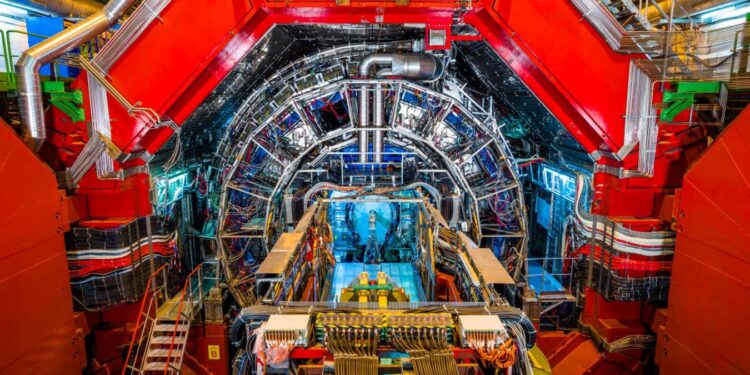
The ATLAS detector at the Large Hadron Collider
xenotar/Getty Images
Hypothetical particles called axions have been sought by physicists for decades, as they are the leading candidate for what makes up dark matter. But we may not need new experiments to find exotic particles similar to axions – evidence of them could be hiding in data from particle collider experiments we have already done.
Particle colliders like the Large Hadron Collider (LHC) at the CERN particle physics laboratory near Geneva, Switzerland uncover new particles by accelerating and crashing together with others we already understand quite well, such as protons and ions, and then analysing the resulting debris. Now, Gustavo Gil da Silveira at CERN and his colleagues have considered another possibility: if a proton or an ion emitted a new particle as a result of being accelerated on its way to getting smashed into bits, would we be able to tell? Their analysis suggests sometimes we could.
Axions were first theorised in the 1970s as part of the solution to one of the largest problems in physics: explaining why more matter than antimatter exists. The search for experimental signatures of axions that followed has so far been unsuccessful, but it has raised the possibility that other axion-like particles could exist. Because these would have very low masses, they would also be similar to particles of light, or photons, which are massless – and have been successfully smashed together at the LHC.
This happens when an accelerated protons or ions get so energetic they start radiating photons as they approach each other, so their surrounding photons also collide. The researchers modelled this scenario, but with axion-like particles in place of photons. Their calculations showed accelerating protons would emit more axion-like particles than accelerating ions, and both would also be emitting photons at the same time. Consequently, the team identified collisions between protons and lead ions as a good place to look for clues of axions crashing into photons. That exact collision – between protons and lead ions – was carried out at the LHC in 2016, and the team suggests data from the experiment could hide hints of previously overlooked but novel axion-like particles.
Lucian Harland-Lang at University College London says this is an interesting and new way to find constraints on which undiscovered particles could exist, but it could also be challenging to implement. “These sorts of collision events do not happen very often, and when that is the case we have to be very sure that there are no background processes that might mimic what we are looking for,” he says.
When it comes to old LHC data, there are also difficulties with accessing it because of subsequent changes in software, says da Silveira. But he says upcoming experiments at the LHC could be more promising. “We could tune the detectors in order to find this particular signal,” he says.
Finding the signal of an axion-like particle wouldn’t be the same as finding an axion, so it may not fully answer one big open question in physics. Yet it would certainly lead to a richer view of particle physics, raising questions from how the new particles interact with all existing ones to whether they could also play a role in determining what the mysterious dark matter that fills our universe is made from.
Journal Reference: Physical Review Letters, in press
Topics:
- Large Hadron Collider/
- particle physics
Source link : https://www.newscientist.com/article/2497100-hints-of-exotic-dark-matter-particles-could-be-hiding-in-lhc-data/?utm_campaign=RSS%7CNSNS&utm_source=NSNS&utm_medium=RSS&utm_content=home
Author :
Publish date : 2025-09-23 16:00:00
Copyright for syndicated content belongs to the linked Source.





